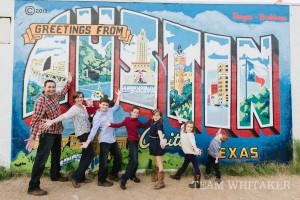Our new church building is beautiful. It’s also huge, easily seating 1,000+ for every Mass, and the wealth of the community is apparent everywhere you look. Custom artwork adorns the walls, and beautiful doors welcome you into the space.
Unless you happen to be handicapped, and then you might get the feeling that you’re not welcome there at all.
Those beautiful hand-scraped doors impress visitors with their obviously-expensive weight. They set the tone for the worship space that lies beyond.
There are nine doorways into the church. All are beautiful. All are heavy. All are self-closing. None are handicapped accessible.
The weak, the frail, the sick, the injured, the handicapped, the very young, the very old – the people St Lawrence referred to as the Treasures of the Church – cannot enter it easily or without help. At no time in the planning of this new and expensive building was accessibility considered to be a priority, and it shows. The automatic door buttons which would have remedied the problem were an additional expense that was not deemed a priority.
The interior is just as imposing, and just as equally inaccessible.
The cathedral ceilings soar, the stained glass glitters, the acoustics are perfection; and yet there is nowhere in this entire church, which seats over 1,000 easily, for a person in a wheelchair to sit. The non-ambulatory members of the parish have the choice of placing themselves either in the middle of an aisle, behind a pillar, or behind the very last pew. Parishioners with walkers have nowhere to place them that is out of the way. The woman at the 10am Mass who has a service dog seats him in the aisle out of necessity.
The problems go on with the bathrooms doors which are too heavy and close too quickly, as do those of the parish offices,the fellowship hall, and the classroom building. The steps to the altar which are steep and have no handrail have effectively eliminated anyone who’s less than sure-footed from reading or serving at Mass. It’s a disgrace which should never have been allowed to happen.
I wish that I could say our parish was unique in its exclusion of the handicapped, but it’s not. Pleas to handicapped support groups and requests for information from parishes across the country have shown the sad truth, this is a wide-spread problem. The age of the building doesn’t matter.The wealth or poverty of the community makes no difference. Handicapped accessibility is not an expense that is high on anyone’s list of priorities.
In talking to people in parish offices as I researched this post, I heard tales of parishioners protesting elevators to the fellowship halls in the basement. Another told me of the outcry over changing the facade of a 100 year old church when a ramp was proposed. The ramp was eventually placed in the back of the building so as not to impact the church’s appearance, making it hard for visitors to find. Even more told me that there wasn’t a need for accessibility in their church at this time.
I was reminded of a friend of mine who was once asked by the priest of her tiny parish to interpret the Mass into sign language when there weren’t any deaf parishioners. He explained to her that there was the chance that a deaf person might wander into his church and he didn’t want that person to miss out on the Mass. The word that she was at the noon Mass quickly spread through the deaf community, and by the end of that year they had 40 deaf parishioners who were thrilled to be able to “hear” what was going on, many for the first time.
We are in the midst of a battle for accessibility in our own parish. We’ve heard all of the excuses about the small number of people for whom this is an issue, and the expense, and the inconvenience…and we refuse to listen. We simply keep reminding the powers-that-be that once upon a time there was a crippled man who wanted nothing more than to be near Jesus, but his infirmity prevented his being able to make his way through the crowds. When they perceived his need, the people who loved him ripped the roof off of the building because no remodeling project was too big to undertake in getting that one crippled man into the presence of the Lord.
What can parishes do to be welcoming to the physically handicapped?
- Those push-button door openers on at least one set of doors would be amazing!
- If you can’t afford the $2,500 approx. per door, then please dismantle or slow down the self-closing mechanisms. Having a door slam into you when you’re not in a position to catch it is dangerous.
- If that doesn’t work, prop the door open.
- Have door greeter/opener people as a last resort. People leave or wander off. It’s not entirely their fault, stuff happens, it just means that the handicapped can’t get in/out until help arrives.
- Handicapped parking with room for a chair lift is a must. This is a huge need especially in older or urban parishes where that may not have been a consideration when the parking lot was built. The absence of room to load/unload a wheelchair means that our family cannot attend your parish.
- Handicapped entrances near the handicapped parking. Can you imagine having to go all the way around the church through the rain when you’re sitting down (and your hands are getting filthy from the mud and rain) because of someone’s poor planning? Been there, done that. It’s really no fun.
- Handicapped accessible bathrooms near the handicapped entrance. Sometimes you’ve just really gotta go!
- Handicapped stalls and hand rails do not make a bathroom accessible. Ask whether or not a person with physical limitations get in and out of the door, and remedy what’s wrong. (Is it heavy? Is there too sharp of an angle to get a wheelchair around?)
- If the door is difficult to open, it needs to be fixed.
- If it’s feasible to remove it completely without compromising modesty, that’s a really cheap fix.
- Ramps need to end flush with the sidewalk. Powerchairs can’t go over those bumps, and it takes a bit of coordination for someone in a manual chair to make it. Please find a way to smooth it out.
- Wide aisles that have room for a chair to fit in the Communion line for anyone who wants to receive with their family and/or the rest of the congregation.
- A cutout or niche in at least one pew where a chair, walker, service dog, or stroller could easily fit.
- At least one outlet in the sanctuary where oxygen tanks or equipment could be plugged in in the case of low batteries or an emergency.
- Please remember that the sanctuary isn’t the whole church. If you’re having doughnuts in the hall, is there a way for everyone to get there? Is there an elevator or chair lift available if the hall is up or downstairs?
- Remember that people with physical limitations aren’t trying to be annoying or exasperating. They have the same need for the Sacraments that the rest of us do. We have a moral obligation to do everything we can to make sure it’s feasible for everyone to be able to receive them.
- It doesn’t have to happen over night. Slow and steady progress is still progress and is welcoming because it shows concern for the well-being of the differently-abled.
At the end of the day, we need to remember that the Church is supposed to be the Church of everyone, not just the people who are strong enough and able enough to make it through the doors.
**Edited to add: There have been many questions about how this new church could be built without having to be ADA compliant. Quite simply, the ADA guidelines DO NOT APPLY TO CHURCHES!! (yes, I’m yelling about it because it ticks me off.)
A special thank you to Kelly Mantoan from This Ain’t the Lyceum for help with brainstorming what would help make our kids’ lives a little easier.















